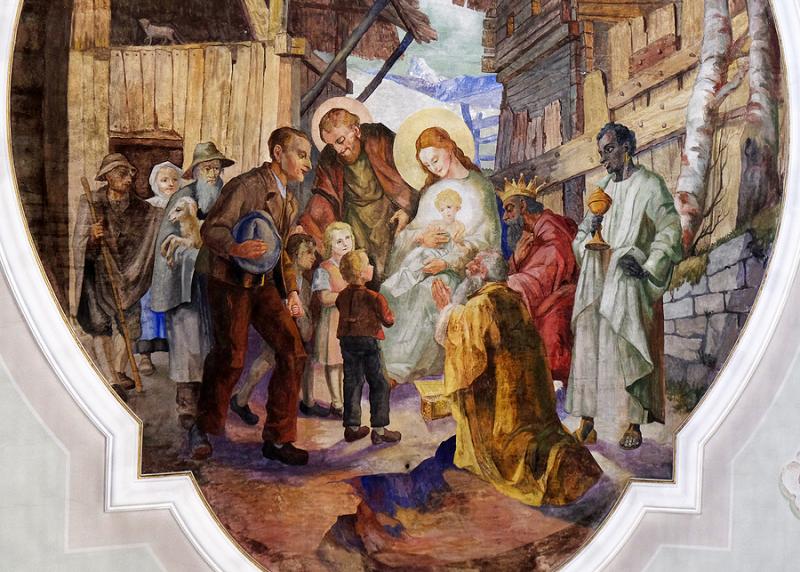On December 25, Christians around the world celebrate the birth of Christ as it’s described in the Gospels. Over the course of centuries, artists experimented with different ways to retell the humble yet extraordinary story of the Virgin Mary’s delivery of a savior in the form of an infant.
For Italian Renaissance artists, the subject of the Nativity became fodder for different types of artistic experimentation. According to legend, the tradition of live nativity scenes began with Saint Francis of Assisi, who first reenacted the birth of Christ using actors and animals performing for a public audience in the central Italian town of Greccio in 1223.
Over time, popular piety and the Italian love of public processions only fueled this tradition. Across the Italian peninsula, the birth of Christ with his parents emerged as a popular subject. By the late Middle Ages, sculptural nativity groups with the Virgin and baby Jesus are documented in churches across Italy. In Naples, for example, sculptors were beginning to design ensembles with lifelike figures inside the city’s churches. Elaborate religious groupings crafted of wood, terracotta, and other materials began appearing across town.
By the fourteenth century, the Nativity had evolved as a popular subject among Italian painters. The subject is immediately recognizable: the newborn Christ in the center of the composition, surrounded by Mary, Joseph, animals, and sometimes the presence of visiting saints, kings, or other figures. In the earliest depictions of the subject, we see hallmarks that will be repeated for centuries to come:
• From the start, Italian painters focused on the fragility of the newborn and the wonder of his miraculous conception and birth.
• The ox and ass, mentioned in Isaiah 1:3, make an appearance.
• Mary’s husband Joseph often appears, but typically he is relegated to a secondary position so he does not appear as the father to the Christ Child.
• Shepherds who were the first to witness his appearance on earth are often included.
Let’s have a look at how Italian painters have handled this subject over the centuries:
Duccio di Buoninsegna, The Nativity with the Prophets Isaiah and Ezekiel, ca. 1308-11, National Gallery of Art, Washington, DC

Fourteenth-century depictions of the nativity rely on Byzantine visual elements such as shepherds kneeling before a boxlike crib. Typical of early fourteenth-century panel painting, Duccio’s Nativity is composed of flat spatial relationships with overlapping planes, and gilded halos and other details. Interestingly, Duccio combines both a cave-like shelter, more popular in the East, with a horse stable, more commonly depicted in Western art as Christ’s birthplace. These panels were once part of a massive, complex altarpiece called the Maestà, a celebrated masterpiece inside Siena Cathedral that was later broken into pieces scattered in museums around the world.
Fra Angelico (and perhaps Benozzo Gozzoli), Nativity, ca. 1440, San Marco, Florence

This fresco, painted on the wall of a monk’s cell at San Marco in Florence, displays a classic composition with the Christ Child in the center, surrounded by the Holy Family, saints, and animals. While the medieval cave / stable combination and gilded halos are still present, the artist includes a three-dimensional perspective that had become the norm in Florentine painting by the mid-fifteenth century. Some art historians believe that Fra Angelico’s pupil, Benozzo Gozzoli, who was also a Dominican friar at San Marco, may have had a hand in this fresco.
Andrea Mantegna, Adoration of the Shepherds, ca. 1450, Metropolitan Museum of Art

Painted in his early twenties, Andrea Mantegna imagines the nativity story unfolding against a dramatic landscape with a ruined classical structure. In the distance stands Golgotha, encapsulating the birth and sacrifice of Christ in a single image. In the foreground, the Christ Child lies inside the folds of Mary’s gown. The awestruck shepherds approach with ripped clothing and bare feet.
Francesco di Giorgio Martini, Nativity, ca. 1475, Pinacoteca Nazionale, Siena
Francesco di Giorgio Martini was a Renaissance man in every sense of the word, displaying a mastery of not only painting but also sculpture, engineering, writing, and architecture. He created this Nativity for a monastery in his hometown of Siena. Similar to Mantegna’s depiction, Martini’s Nativity unfolds before a ruined structure and a distant landscape, little more than a display of his artistic skill. Saints Bernard and Thomas Aquinas—both important to the monastery patrons who commissioned this work—observe the infant from the left side.

Sandro Botticelli, The Mystical Nativity, ca. 1500, National Gallery, London

This fascinating, unconventional depiction of the Nativity has inspired various interpretations. Rather than retelling a story, Sandro Botticelli presents us with a surreal vision of the event, perhaps inspired by the prophecies of Revelation. A gigantic Mary and Jesus anchor an otherwise chaotic composition filled with angels, devils, and saints, plus texts in Greek and Latin. Some art historians have suggested that this work incorporates themes from the sermons of the Dominican friar Girolamo Savonarola, whom Botticelli may have followed for a time toward the end of his life. This picture is Botticelli’s only surviving signed painting.
According to the Gospels, several days after the birth, three wise men from the East—the Magi—traveled to see the infant, bearing exotic gifts. This interesting subject of the so-called Three Kings, is another popular subject for Italian painters, and a topic for another day.
P.S. Painting isn’t the only artistic tradition of nativity art in Italy. Check out the extraordinary Neapolitan tradition of papier-mâché nativities, as well as the tradition of nativity woodcarving in Italy’s Alpine regions.
Laura Morelli is an art historian and historical novelist with a passion for Italy. You can find much more about what to bring home from Italy in her guidebook series, including Made in Florence and Made in Italy. These books, along with Laura’s Venice-inspired historical novels, including The Gondola Maker, are available in the Italy Magazine shop. Her new novel, The Night Portrait—a dual-timeline story based on Leonardo’s Lady with the Ermine—is out now.









